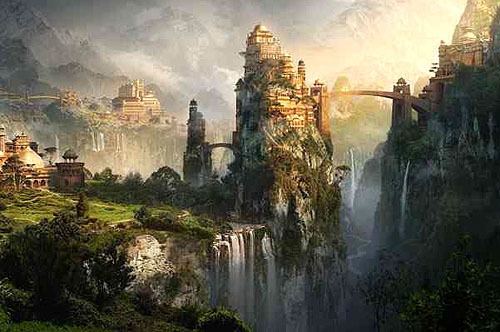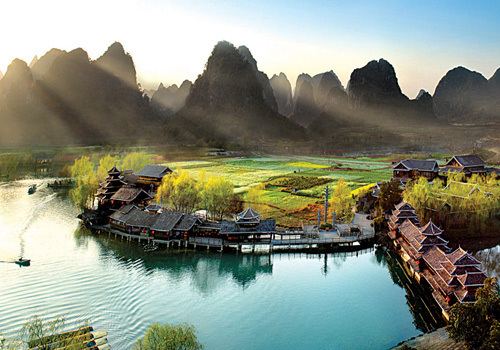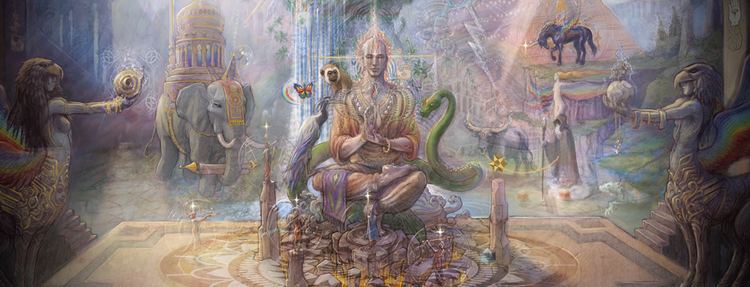 | ||
Shangri-La is a fictional place described in the 1933 novel Lost Horizon by British author James Hilton. Hilton describes Shangri-La as a mystical, harmonious valley, gently guided from a lamasery, enclosed in the western end of the Kunlun Mountains. Shangri-La has become synonymous with any earthly paradise, and particularly a mythical Himalayan utopia – a permanently happy land, isolated from the outside world. In the novel Lost Horizon, the people who live at Shangri-La are almost immortal, living years beyond the normal lifespan and only very slowly aging in appearance. The name also evokes the imagery of exoticism of the Orient. In the ancient Tibetan scriptures, existence of seven such places is mentioned as Nghe-Beyul Khembalung. Khembalung is one of several beyuls ("hidden lands" similar to Shangri-La) believed to have been created by Padmasambhava in the 9th century as idyllic, sacred places of refuge for Buddhists during times of strife (Reinhard 1978).
Contents
- Paleface helsinki shangri la official video
- Etymology
- Location
- In popular culture
- In astronomy
- Gardens and resorts
- In film
- In television
- In literature
- In video gaming
- In music
- In politics
- Other
- Usage
- References
Some scholars believe that the Shangri-La story owes a literary debt to Shambhala, a mythical kingdom in Tibetan Buddhist tradition, which was sought by Eastern and Western explorers.

Paleface helsinki shangri la official video
Etymology

The phrase "Shangri-La" most probably comes from the Tibetan ཞང་,"Shang" – a district of Ü-Tsang, north of Tashilhunpo" + རི, pronounced "ri", "Mountain" = "Shang Mountain" + ལ, Mountain Pass, which suggests that the area is accessed to, or is named by, "Shang Mountain Pass".
Location

In China, the poet Tao Yuanming of the Jin Dynasty (265–420) described a kind of Shangri-La in his work The Tale of the Peach Blossom Spring (Chinese: 桃花源記; pinyin: Táohuā Yuán Jì). The story goes that there was a fisherman from Wuling, who came across a beautiful peach grove, and he discovered happy and content people who lived completely cut off from the troubles in the outside world since the Qin Dynasty (221–207 BCE). In modern China, Zhongdian county was renamed Xiānggélǐlā (香格里拉, Shangri-La in Chinese) in 2001, to attract tourists. The legendary Kun Lun Mountains (崑崙山) offer another possible place for the Shangri-La valleys.
A popularly believed physical inspiration for Hilton's Shangri-La is the Hunza Valley in northern Pakistan, close to the Chinese border, which Hilton visited a few years before Lost Horizon was published. Being an isolated green valley surrounded by mountains, enclosed on the western end of the Himalayas, it closely matches the physical description in the novel. The Hunza Valley, however, lacks Tibetan culture and the Buddhist religion, so could not have been Hilton's cultural inspiration for Lost Horizon.
The cultural representation of Shangri-La is most often cited to be northwestern Yunnan Province, China, where National Geographic explorer Joseph Rock lived and traveled during the 1920s and early 1930s and wrote several articles in National Geographic magazine that are richly illustrated with superb photography. This coincides with the time when James Hilton would have been writing Lost Horizon, but there is no direct evidence to support this claim. The evidence points to another set of explorers. In a New York Times interview in 1936, Hilton states that he used "Tibetan material" from the British Museum, particularly the travelogue of two French priests, Evariste Regis Huc and Joseph Gabet, to provide the Tibetan cultural and Buddhist spiritual inspiration for Shangri-La. Huc and Gabet travelled a roundtrip between Beijing and Lhasa in 1844–46 on a route more than 250 kilometres (160 mi) north of Yunnan. Their famous travelogue, first published in French in 1850, went through many editions in many languages. A popular "condensed translation" was published in England in 1928, at the time that Hilton would have been getting inspired for – or even writing – Lost Horizon.
Today, various places claim the title, such as parts of southern Kham in northwestern Yunnan province, including the tourist destinations of Lijiang and Zhongdian. Places like Sichuan and Tibet also claim the real Shangri-La was in its territory. In 2001, Tibet Autonomous Region put forward a proposal that the three regions optimise all Shangri-La tourism resources and promote them as one. After failed attempts to establish a China Shangri-la Ecological Tourism Zone in 2002 and 2003, government representatives of Sichuan and Yunnan provinces and Tibet Autonomous Region signed a declaration of cooperation in 2004. Also in 2001, Zhongdian County in northwestern Yunnan officially renamed itself Shangri-La County.
American explorers Ted Vaill and Peter Klika visited the Muli area of southern Sichuan Province in 1999, and claimed that the Muli monastery in this remote region was the model for James Hilton's Shangri-La, which they thought Hilton learned about from articles on this area in several National Geographic magazine articles in the late 1920s and early 1930s written by Austrian-American explorer Joseph Rock. Vaill completed a film based on their research, "Finding Shangri-La", which debuted at the Cannes Film Festival in 2007. However, Michael McRae unearthed an obscure James Hilton interview from a New York Times gossip column where he reveals his cultural inspiration for Shangri-La and, if it is any place, it is more than 250 km north of Muli on the route travelled by Huc and Gabet.
Between 2002 - 2004 a series of expeditions were led by author and film maker Laurence Brahm in western China which determined that the Shangri-La mythical location in Hilton's book Lost Horizon was based on references to northern Yunnan Province from articles published by National Geographic's first resident explorer Joseph Rock.
Shambhala is a core concept in Tibetan Buddhism that describes a realm of harmony between man and nature that is also connected with the Kalachakra or "wheel of time". The Shambhala ideal is described in detail in the Shambhala Sutra, a historical text written by the Sixth Panchen Lama (1737-1780) which describes some of the Shambhala locations in Ngari the western prefecture of Tibet, documented in Brahm's 2004 film expedition Shambhala Sutrah.
On December 2, 2010, OPB televised one of Martin Yan's Hidden China episodes, "Life in Shangri-La", in which Yan said that "Shangri-La" is the actual name of a real town in the hilly and mountainous region in northwestern Yunnan Province, frequented by both Han and Tibetan locals. Martin Yan visited arts and craft shops, local farmers as they harvest crops, and sampled their cuisine.
Television presenter and historian Michael Wood, in the "Shangri-La" episode of the BBC documentary series In Search of Myths and Heroes, suggests that the legendary Shangri-La is the abandoned city of Tsaparang in upper Satluj valley, and that its two great temples were once home to the kings of Guge in modern Tibet.
In Altai Mountains folklore Mount Belukha is also believed to be a gateway to Shambhala.
In popular culture
There are a number of cultural usages of the Shangri-La idea that have developed since 1933 in the wake of the novel and the film made from it.
In astronomy
In 2006, the International Astronomical Union named the equatorial, dark, low-lying area of Saturn's moon Titan Shangri-La.
Gardens and resorts
In 1937, Lutcher Stark, a Texas philanthropist, started building his own Shangri-La in Orange, Texas. His Shangri-La was an azalea garden situated alongside a cypress-tupelo swamp. By 1950, thousands of people were traveling to Orange to visit Shangri-La, and many magazines published photographs of it. In 1958, a major snowstorm struck east Texas, destroying thousands of azaleas and closing the garden for 40 years. The garden has recently been renovated and is now open to the public once again.
The businessman Harold Nixon Porter established a nature reserve called Shangri-La in Betty's Bay in South Africa in 1955. The name was changed to Harold Porter National Botanical Garden when the reserve was bequeathed to the National Botanic Gardens of South Africa in 1959.
In 1983, a tourist resort built on the banks of Kachura Lake in Skardu, northern Pakistan, was based on the idea of Hilton's novel. The resort is named Shangrila Resort. Today, the lake itself is also known as Shangrila Lake.
In film
California's Ojai Valley was the location for the Frank Capra film Lost Horizon (1937). The outdoor scenes of the villagers of Shangri-La and a cavorting Ronald Colman and Jane Wyatt were in fact filmed in nearby Sherwood Forest (Westlake Village) and Palm Springs. The exterior of the grand lamasery was built and later dismantled on the Columbia Ranch in Burbank, California. However, according to film historian Kendall Miller in the photodocumentary bonus feature on the Lost Horizon DVD, an aerial shot of Ojai Valley taken from an outlook on Highway 150 was used to represent the Shangri-La valley.
In the Movie Sky Captain and the World of Tomorrow after being knocked unconscious by a large amount of Dynamite, Joe Sullivan (Jude Law), Polly Perkins (Gwyneth Paltrow) and Kaji (Omid Djalili) wake up in Shangri-La and are given new clothes by Tibetan-speaking monks as their old ones had to be burned due to Radiation.
In television
In literature
Eiichi Ikegami wrote a novel titled Shangri-La (2005); an anime adaptation of the novel was released in 2008.
Michael Buckley covers the topic in Eccentric Explorers and briefly in other books.
In video gaming
In music
Songs with "Shangri-La" in the title:
Songs that mention Shangri-La:
Albums with "Shangri-La" in the title:
In politics
Other
Glastonbury Festival created an after-hours area within the site called Shangri-La in 2009. It has evolved over the past three years each with a slightly different theme: In 2009 the socialist utopia became a dystopian pleasure city run by a corrupt regime. In 2010 the ruling administration was overthrown and the city was opened up to rebels and chancers to carve out their own little piece of paradise. The 2011 storyline was pre-apocalyptic – the population of Shangri-La prepared to flee a viral infection before the end of the world. During the festival's fallow year, 2012, the end of the world took place and in the 2013 theme became the afterlife. Shangri-La was divided between Shangri-Heaven and Shangri-Hell, combined to form the Shafterlife. In 2014, the two areas, Heaven and Hell, were themed-based around the perils of the traditional office workplace. 'Shangri- Hell' comprised a collection of self-contained buildings all based on the departments of a corporations head-office. Some were in fact bars and other were display installations for amusement purposes.
Usage
Shangri-La is often used in a similar context to "Garden of Eden," to represent a paradise hidden from modern man. It is sometimes used as an analogy for a lifelong quest or something elusive that is much sought. For a man who spends his life obsessively looking for a cure to a disease, such a cure could be said to be that man's "Shangri-La." It also might be used to represent perfection that is sought by man in the form of love, happiness, or Utopian ideals. It may be used in this context alongside other mythical and famous examples of somewhat similar metaphors such as El Dorado, The Fountain of Youth, and The Holy Grail.
